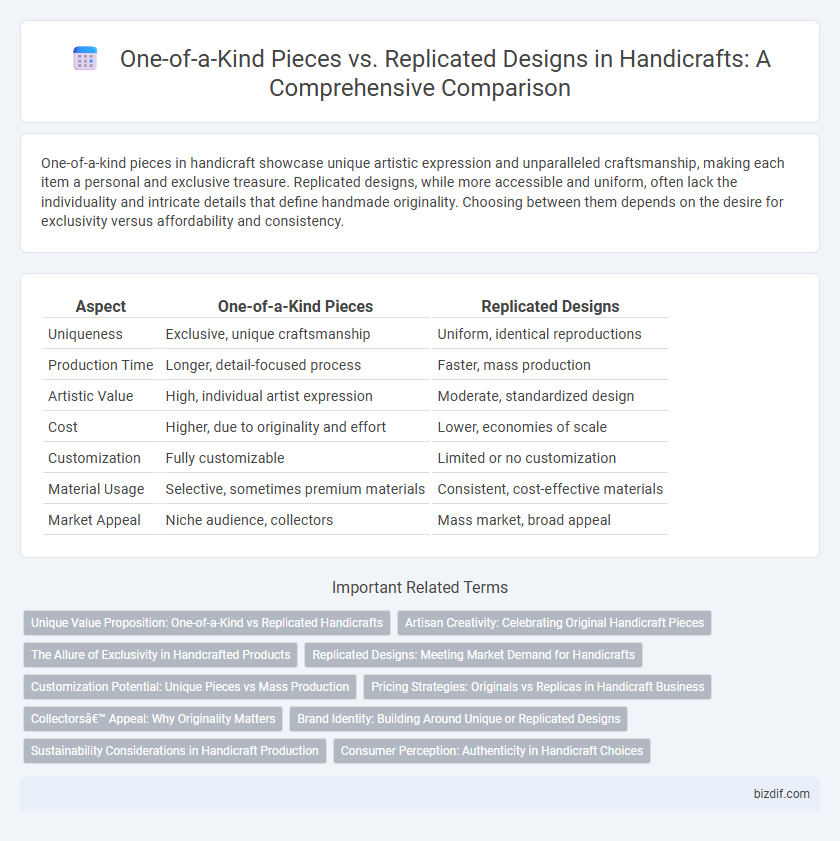One-of-a-kind pieces in handicraft showcase unique artistic expression and unparalleled craftsmanship, making each item a personal and exclusive treasure. Replicated designs, while more accessible and uniform, often lack the individuality and intricate details that define handmade originality. Choosing between them depends on the desire for exclusivity versus affordability and consistency.
Table of Comparison
| Aspect | One-of-a-Kind Pieces | Replicated Designs |
|---|---|---|
| Uniqueness | Exclusive, unique craftsmanship | Uniform, identical reproductions |
| Production Time | Longer, detail-focused process | Faster, mass production |
| Artistic Value | High, individual artist expression | Moderate, standardized design |
| Cost | Higher, due to originality and effort | Lower, economies of scale |
| Customization | Fully customizable | Limited or no customization |
| Material Usage | Selective, sometimes premium materials | Consistent, cost-effective materials |
| Market Appeal | Niche audience, collectors | Mass market, broad appeal |
Unique Value Proposition: One-of-a-Kind vs Replicated Handicrafts
One-of-a-kind handicraft pieces offer unmatched uniqueness and authenticity, showcasing artisan creativity and cultural heritage that cannot be duplicated. Replicated designs, while more accessible and consistent in quality, often lack the distinct character and personal touch inherent in original artworks. The unique value proposition of one-of-a-kind handicrafts lies in their exclusivity and the story each piece carries, attracting collectors and enthusiasts seeking originality over mass production.
Artisan Creativity: Celebrating Original Handicraft Pieces
One-of-a-kind handicraft pieces embody the artisan's unique creativity, showcasing intricate techniques and personal expression that cannot be replicated. These original designs capture cultural heritage and individual craftsmanship, making each item a true work of art. Embracing handcrafted, singular creations supports artisans and preserves the authenticity of traditional craftsmanship.
The Allure of Exclusivity in Handcrafted Products
Handcrafted products offer an unparalleled allure of exclusivity through their one-of-a-kind pieces, each showcasing unique artistic details and individual craftsmanship that mass-replicated designs lack. This exclusivity not only enhances the intrinsic value of the item but also creates a personal connection between the creator and the owner. Collectors and enthusiasts gravitate toward handcrafted goods for their distinctive character, rarity, and the story embedded in every singular creation.
Replicated Designs: Meeting Market Demand for Handicrafts
Replicated designs in handicrafts enable artisans to efficiently meet growing market demand by producing consistent, high-quality items at scale. These designs leverage standardized techniques and materials to ensure uniformity while maintaining traditional craftsmanship elements. This approach balances affordability and accessibility, expanding the reach of handcrafted products to a broader customer base.
Customization Potential: Unique Pieces vs Mass Production
One-of-a-kind handicraft pieces offer unparalleled customization potential, allowing artisans to tailor every detail to individual preferences and cultural significance. Replicated designs, common in mass production, prioritize uniformity and efficiency, often sacrificing the personal touch and intricate uniqueness that custom handcrafted items provide. Consumers seeking exclusive, personalized art invest in unique pieces, while mass-produced items cater to broader markets with consistency and affordability.
Pricing Strategies: Originals vs Replicas in Handicraft Business
Original one-of-a-kind handicraft pieces command premium pricing due to their uniqueness, craftsmanship, and exclusivity, often appealing to collectors and connoisseurs. Replicated designs, produced in larger quantities, adopt competitive pricing strategies aimed at accessibility and mass-market appeal, balancing cost of production with perceived value. Pricing strategies in the handicraft business hinge on factors such as originality, labor intensity, material quality, and market demand, with originals capturing higher margins and replicas driving volume sales.
Collectors’ Appeal: Why Originality Matters
Collectors highly value one-of-a-kind handicraft pieces for their unique craftsmanship, rare materials, and exclusive design elements that cannot be replicated. Originality in handicrafts ensures authenticity and a personal connection, enhancing sentimental and monetary value for collectors. Replicated designs, while accessible, often lack the distinctiveness and story that drive collector demand and long-term appreciation.
Brand Identity: Building Around Unique or Replicated Designs
One-of-a-kind pieces strengthen brand identity by showcasing exclusive craftsmanship and originality that resonates with discerning customers seeking authenticity. Replicated designs enable scalability and brand recognition through consistent aesthetic elements that appeal to broader audiences. Balancing unique creations with replicated offerings allows brands to maintain distinctiveness while expanding market reach and customer loyalty.
Sustainability Considerations in Handicraft Production
One-of-a-kind handcrafted pieces minimize waste by using locally sourced, renewable materials and emphasize uniqueness, reducing the need for mass production. Replicated designs often rely on repetitive processes that can lead to resource depletion and increased environmental impact. Prioritizing artisanal methods in handicraft supports sustainable practices by promoting durability, cultural preservation, and reduced carbon footprints.
Consumer Perception: Authenticity in Handicraft Choices
Consumers perceive one-of-a-kind handicraft pieces as authentic expressions of cultural heritage and artisan skill, enhancing emotional value and exclusivity. Replicated designs, while accessible and consistent, often lack the unique imperfections that signify genuine craftsmanship. Authenticity remains a key factor driving preference for handcrafted items, influencing buyers to prioritize original creations over mass-produced alternatives.
One-of-a-kind Pieces vs Replicated Designs Infographic

 bizdif.com
bizdif.com